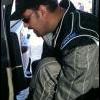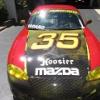
New to alignments help with ride height
#1

 Posted 12-10-2019 03:47 PM
Posted 12-10-2019 03:47 PM

I am Headed into my second season of SM and decided to invest in scales and all the other goodies that go along with chassis setup. I am familiar with all the setup criteria/ lingo all except ride height. I have Been using the pinch welds (usually shoot for 4 1/2 - 4 5/8) all of last season until I looked at the bump stops at nasa championships and found the bump stop washer was all sorts of bent. The kind guys at Mazda gave me new ones and said to use a coat hanger to measure ride height. Can any of you explain the coat hanger method(where does it go/how do you know what is right or wrong)or a better method to use for ride height? Also a good base line to start at so I can adjust from there would be awesome. If anyone has pictures it would also be super helpful as I sometimes have hard times wrapping my head around text.
Thanks for the help
#2

 Posted 12-10-2019 05:35 PM
Posted 12-10-2019 05:35 PM

I drive a NA 1.6 and run about 3/4" gap in the front and 5/8" in the back, which I consider low ride height. This is of course effected by corner weight.


#3

 Posted 12-10-2019 06:08 PM
Posted 12-10-2019 06:08 PM



#4

 Posted 12-10-2019 08:47 PM
Posted 12-10-2019 08:47 PM

You are measuring the space between the top of the shock and the bottom of the bump stop. Some folks make a feeler gauge out of a coat hanger so they can reach in with it and confirm gap dimension. Kinda looks like this -----------\_!
I drive a NA 1.6 and run about 3/4" gap in the front and 5/8" in the back, which I consider low ride height. This is of course effected by corner weight.
Now that makes sense thank you. How do I go about setting this up before races at the shop? Bump stop all the way to the top hat then measure ? Thanks for the beginner help.
#5

 Posted 12-11-2019 08:19 AM
Posted 12-11-2019 08:19 AM



#6

 Posted 12-11-2019 10:58 AM
Posted 12-11-2019 10:58 AM

#7

 Posted 12-11-2019 11:20 AM
Posted 12-11-2019 11:20 AM

#8

 Posted 12-12-2019 12:29 PM
Posted 12-12-2019 12:29 PM

Penske instructions provide recommended setup starting point dimensions of Front: 10 1/8 inch and Rear: 6 1/8 inch. These dimensions are based on measuring from the centerline of lower shock mounting bolt to the shock adjuster spring seat top surface that the spring sits on.
The above method provides a consistent method that will not be affected by tire rolling radius (as affected by tire pressure setting and amount of tire wear) or pinch weld changes due to jacking or "gator" strike damage. Obviously it is important to pay attention to tire pressure settings in addition to disconnecting of sway bars for accurate/consistent cross weight settings. The actual jounce bumper to shock body gap will vary as a function of both unique vehicle dimensional characteristics along with the distribution of weight throughout the vehicle but in general the corners carrying the highest loads will tend have the smallest gaps (at static ride height).
I do not use this method as I have not seen an easy and consistent way to make this measurement but have correlated the above to a similar method I have used over the years which accomplishes the same thing. I use a Starrett small T-square which has a 1/4 inch wide, 6 inch long machinist scale graduated as fine as 64's of an inch. Using this simple tool I measure by placing the T-square cross piece against the bottom of the threaded adjuster sleeve and push the 1/4 inch machinist scale up against the bottom of the threaded spring seat. After locking the rule in place simply remove the tool and observe the reading (be sure to have ruler set to increase in reading as you push it up against the bottom of the treaded spring seat collar). Typically you will have a dimension range of 1 & 30/64 inch to as much as 2 & 8/64 inch using this tool and method. With this method, if you are not able to access the shock to make this measurement, you can do after recording cross weights by taking the car off the scales, even removing a wheel if you wish, as the dimensions are fixed and can be captured after the fact. In fact it is a good way to capture any changes made at the track.
Rich Powers
#9

 Posted 12-12-2019 01:42 PM
Posted 12-12-2019 01:42 PM

Penske instructions provide recommended setup starting point dimensions of Front: 10 1/8 inch and Rear: 6 1/8 inch. These dimensions are based on measuring from the centerline of lower shock mounting bolt to the shock adjuster spring seat top surface that the spring sits on.
The above method provides a consistent method that will not be affected by tire rolling radius (as affected by tire pressure setting and amount of tire wear) or pinch weld changes due to jacking or "gator" strike damage. Obviously it is important to pay attention to tire pressure settings in addition to disconnecting of sway bars for accurate/consistent cross weight settings. The actual jounce bumper to shock body gap will vary as a function of both unique vehicle dimensional characteristics along with the distribution of weight throughout the vehicle but in general the corners carrying the highest loads will tend have the smallest gaps (at static ride height).
I do not use this method as I have not seen an easy and consistent way to make this measurement but have correlated the above to a similar method I have used over the years which accomplishes the same thing. I use a Starrett small T-square which has a 1/4 inch wide, 6 inch long machinist scale graduated as fine as 64's of an inch. Using this simple tool I measure by placing the T-square cross piece against the bottom of the threaded adjuster sleeve and push the 1/4 inch machinist scale up against the bottom of the threaded spring seat. After locking the rule in place simply remove the tool and observe the reading (be sure to have ruler set to increase in reading as you push it up against the bottom of the treaded spring seat collar). Typically you will have a dimension range of 1 & 30/64 inch to as much as 2 & 8/64 inch using this tool and method. With this method, if you are not able to access the shock to make this measurement, you can do after recording cross weights by taking the car off the scales, even removing a wheel if you wish, as the dimensions are fixed and can be captured after the fact. In fact it is a good way to capture any changes made at the track.
Rich Powers
Would the measurement you describe vary from side to side depending on weight distribution. Such as the left front having more threads showing than the right front and essentialy having the same ride height? Or have I misunderstood your method ?
Blake
#10

 Posted 12-12-2019 04:56 PM
Posted 12-12-2019 04:56 PM



#11

 Posted 12-12-2019 06:06 PM
Posted 12-12-2019 06:06 PM

Agree with Steve (above) in trying to get to a neutral 50% cross weight setup with the least amount of deviation side to side and front to rear. You do not want to try achieving your desired cross weight by just raising/lowering on one "axis" (especially on a track that has a balance of left and right turns). Instead make small adjustments in appropriate directions at all four positions to bring the cross in without significantly changing the net ride height, especially if it is a track that you do not have any historical setup information to work with.
From there you can raise or lower the rear to address oversteer/understeer and add some wedge of de-wedge to help with unique track characteristics or vehicle responses.
I keep a log of the setup as taken to track and make notes of changes make at the track but always do a post race inspection to verify the readings coming off the track so that I capture the actual setup after the fact in a more controlled environment than the track.
- Steve Scheifler likes this
#12

 Posted 12-13-2019 11:37 AM
Posted 12-13-2019 11:37 AM

Some smart guy, I think his name is Saul, once told me to think of the car as a four-legged stool. For example, if you raise the LF and RR half a turn, then lower the RF and LR a half a turn.


#13

 Posted 12-13-2019 05:56 PM
Posted 12-13-2019 05:56 PM

Some smart guy, I think his name is Saul, once told me to think of the car as a four-legged stool. For example, if you raise the LF and RR half a turn, then lower the RF and LR a half a turn.
I dont want to sit on that stool ![]()
Ron
RAmotorsports


#14

 Posted 01-06-2020 02:36 PM
Posted 01-06-2020 02:36 PM

I dont want to sit on that stool
Glad someone else noticed that stool would be a rockin'!

#15

 Posted 05-26-2020 07:18 PM
Posted 05-26-2020 07:18 PM

I’m setting up my “new-to-me” car with penskes and I don’t have a baseline to start from. This car has really beat up pinch welds so I am setting it up using the bumpstop gap distance front and rear. I used to setup my last SM in the 4 3/8” - 4 1/2” with the Bilsteins which I used the bumpstop finger gap method as a litmus test.
My question is, is anyone measuring their bumpstop gap?
My first go around, I’m at 1.5” of bumpstop gap all the way around. Unfortunately, it’s tough to tell if I’m close.
#16

 Posted 05-27-2020 04:33 AM
Posted 05-27-2020 04:33 AM

I don't know if this answers your question, but i set up my car exactly the same with the Penske, Start there and adjust as needed at the track but the RH and camber I set the same as before.
Frank
TnT Racing
SCCA Ohio Valley Region




#17

 Posted 05-27-2020 10:13 AM
Posted 05-27-2020 10:13 AM



#18

 Posted 05-27-2020 02:21 PM
Posted 05-27-2020 02:21 PM

I did not. Last year, I swapped them on for one race by just leaving everything exactly how they came off the Bilsteins, BUT I have no idea if this car was setup at all when I got it. This winter I did a bunch stuff to the suspension, including new adjusters etc.
I will see if I can find the instructions for those measurements. I was hoping to hear someone say "X.X bumpstop clearance should get you close"
#19

 Posted 05-31-2020 06:14 PM
Posted 05-31-2020 06:14 PM

Here is some information that can be used to establish the relationship/correlation of what Penske recommends as minimum settings when measured from the top (spring seat) surface of the shock adjuster sleeve to centerline of lower shock mounting bolt. That recommendation being 10.125 inches Fronts and 6.125 inches Rears.
Using my preferred alternate method (utilizing a Starrett 2" wide base T-square with 1/4" wide 6" machinest scale graduated in 64's of an inch"), I have established the following correlation to the above Penske recommended minimum values (using the T-square tool to measure from the bottom of the shock body threaded adjuster sleeve up to the bottom of the Lower Spring Seat Adjuster collar). This correlation is as as follwows; The Front 10.125 value becomes 1.750 inch (1 48/64" on scale) and the Rear 6.125 inch value becomes 1.531 (1 34/64" on scale).
Having established this relationship to the Penske mimimum recommendations it is then possible to show how the new measurement method can be used in establishing the total relationship to an actual car setup as shown in the following measured values/settings.
Item Setting or Measurement: Lft Rr Lft Frt Rt Frt Rt Rr
Scale Pos Weight (Lbs) 589 642 603 570
T-Sq Shoc Adjr Measure 1"& 60/64 1"& 46/64 1"& 40/64 1"& 45/64
(1.938") (1.719") (1.625) (1.703")
Measured Jounce Bumper Gap 1.912" 1.562" 1.452" 1.857"
(measured from top of shock body to underside of jounce bumper cushion using gauge blocks)
Please note that there is no correlation of the shock adjuster measurement value to the jounce bumper gap as this gap is a function of the spring loading at each individual position. You can correlate the T-Sq Shock Adjuster measurement just by looking at the 1 48/64 minimum recommendation for the fronts and the 1 34/64 minimum recommendation for the Rears. In doing so you see that this setup does deviate from the Front 1 48/64" guideline given the two front settings being slightly below the "correlated" Penske minimum recommendation.
Hope this helps show what you might expect to find when acutally setting up a car but be aware that every car is different and the results between cars may have reasonable variations around these values. While I have measured the pinch weld heights I do not like to use them due to the high variation between cars as well as how easily they can become damaged rendering an historical information worthless.
Rich Powers
#20

 Posted 06-01-2020 12:51 PM
Posted 06-01-2020 12:51 PM

Rich,
Awesome. This was very helpful and hopefully others can utilize this info. We did something very similar to help get close. I had my teammate get the same measurements that you did from his 1.6 SM that has penskes on it. In measuring bumpstop clearance I made a measuring device that is T shaped and I can slip into the space.
How are you setting up your car Rich? Are you making the car level by setting the same bumpstop clearance all the way around?
Kyle
Also tagged with one or more of these keywords: Alignmentsbumpstop, Penske, pi

|
Spec Miata →
Spec Miata (SM) →
Looking for used SM suspensionStarted by marchewitt , 09-02-2022 |
|

|
1 user(s) are reading this topic
0 members, 1 guests, 0 anonymous users




 Sign In
Sign In Create Account
Create Account



 Back to top
Back to top Report
Report





